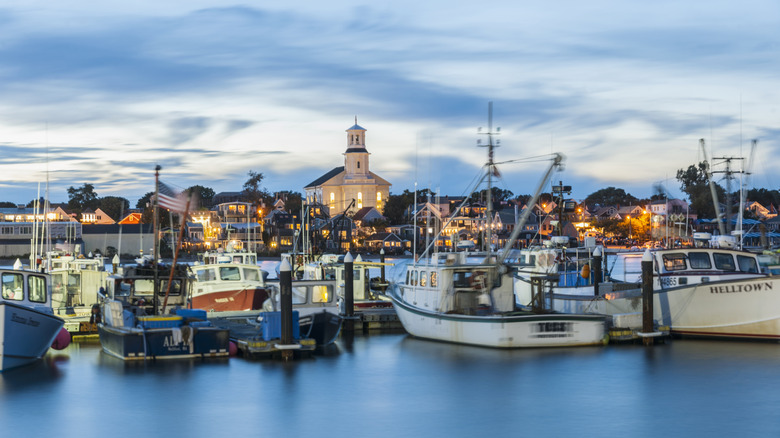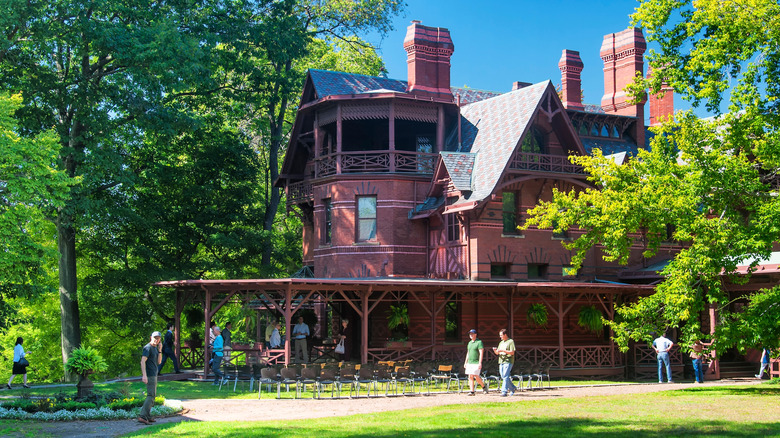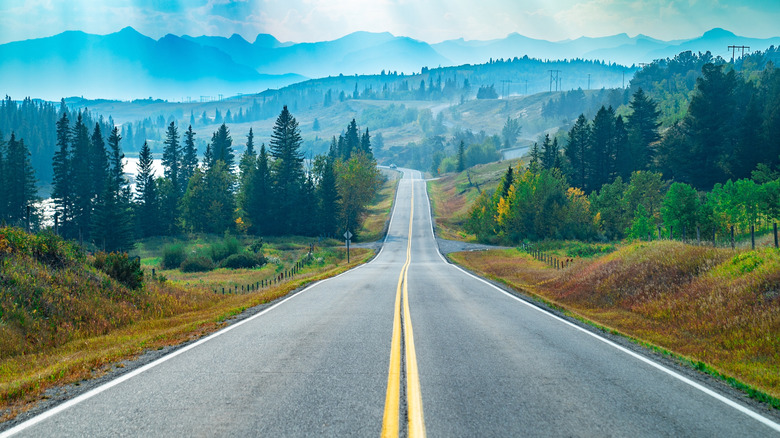One Of America's Longest Highways Offers A Coast-To-Coast Road Trip With Historic Sights
We may receive a commission on purchases made from links.
The Nat King Cole Trio may have immortalized Route 66 in the 1946 R&B melody "(Get Your Kicks on) Route 66," but there's a lesser-known cross-country highway that runs an almost parallel northern route connecting the East and West Coasts. Route 6 begins Provincetown, Massachusetts (one of the most picturesque towns on the East Coast) on the eastern tip of Cape Cod and passes through 14 U.S. states en route to its western terminus in California. If not for the catchy lyrics penned by mid-20th-century jazz musician Bobby Troupe, both transcontinental routes may have fallen into equal obscurity with the introduction of more streamlined travel via the U.S. Interstate Highway System in the 1950s. But the little ditty Troupe and his then-wife, Cynthia, composed while driving along Route 66 (still one of America's most scenic road trips) to seek fame and fortune in Los Angeles catapulted one transcontinental route into our collective consciousness while the other faded into its shadow.
In the end, the lure of convenience over experience won out, jettisoning both original highways into the realm of nostalgic Americana. Route 66 was decommissioned in 1985, but subsequent covers of the Nat King Cole Trio's original hit song — including releases by Glenn Fry, Natalie Cole, and even The Rolling Stones — have kept it in the public consciousness. Route 6, on the other hand, is still a commissioned highway, but it remains almost unknown save for a few spots along its cross-country expanse where it's either a well-traveled local roadway or where it's become an attraction in its own right. That's a shame because the lesser-known byway encompasses a cross-section of the American landscape that few other routes in the U.S. Interstate Highway System can match.
Let's start at the beginning
It all began in 1925 when the Joint Board on Interstate Highways proposed creating a 75,884-mile numbered highway system criss crossing the country. Route 6 was part of that original plan. The 1925 proposal laid out what ultimately became the first leg of the one-time longest transcontinental highway in the United States — a title it has shared on and off with U.S. Route 20. The proposal laid out a route plan that started in Provincetown, Massachusetts, and continued through New Bedford and Fall River (a great autumn destination for a spooky East Coast day trip) before crossing into Rhode Island, Connecticut, New York, and ending in Pennsylvania. For the record, the Cape Cod portion of the original roadway connecting Provincetown to the Cape Cod Canal is known today as Route 6A. It was bumped to secondary status when the Mid-Cape Highway opened in the 1950s. Subsequently, the newer two- to four-lane highway became the official Route 6. It's a reasonably pleasant drive, but at its core, it's just another generic highway.
The real experience lies in exploring the original byway, today's Route 6A. Also known as Old King's Highway, Route 6A runs from Provincetown to the Cape Cod Canal, through picture-perfect New England villages and by historic homes dating to the colonial era. Along the way, unassuming side roads lead to pristine bayside beaches and (sometimes) unmarked pull-overs offer access to walking trails through salt water marshes. The byway is so quintessentially New England that HGTV recently designated it the perfect road trip to experience historic Cape Cod. And we're just getting started. By the time you reach the Cape Cod Canal in Bourne, Massachusetts, you have only traveled the first 65 miles of what is now 3,000-plus-mile-long transcontinental roadway.
From sea to shining sea
Before we move on, let's clear up any lingering confusion about the actual length of Route 6, coast to coast. It's the sticking point that leads to a debate about which is longer, Route 6 or Route 20. Technically, both have held the crown at one time or another. Route 6 originally reached its West Coast terminus in Long Beach, California (home to one of the biggest Halloween events in America) with an official length of 3,652 miles. When California introduced a new statewide highway numbering system in 1964, the Route 6 end point changed to Bishop, California, shortening its official length to 3,227 miles, 118 miles shorter than Route 20.
Marking its 100th anniversary in 2025, the coast-to-coast drive is by no means a direct route today. Like its Cape Cod link, the 3,000-plus-mile-long roadway was built piecemeal with links constructed as needed to connect long-established regional roadways, and in some places, even wagon trails. Despite the patchwork, the original route is still discernible. It may be twisty-turny, but true highway history fans will not be deterred in their quest to trace Route 6 start to finish. The journey passes through 14 U.S. states, encompassing an extraordinary cross-section of American landscape, including everything from historic villages and coastal towns to arid deserts and rugged mountains to expansive plains and towering forests. It's an experience few, if any, other routes in the U.S. Interstate Highway System can match. Also known as the Grand Army of the Republic Highway, while some of the communities that once thrived as rest stops along the coast-to-coast route have faded into obscurity, others have embraced their role in Americana. Let's take an east-to-west look at some of the highlights you'll encounter along the way.
The long and winding road
We covered the first 65 miles of the journey from Provincetown, Massachusetts to the Cape Cod Canal. After crossing the canal, continue through southeastern Massachusetts and into Rhode Island where highlights along the way include Roger Williams Park Zoo in Providence. The AZA-accredited zoo opened in 1872. For a taste of nostalgia, stop at Cindy's Diner in North Scituate. About 15 miles east of where Route 6 crosses into Connecticut, the old-world diner is a local favorite known for its Yankee Pot Roast. Just across the border, the Connecticut Turnpike splits off to the south. Stay on Route 6 and you'll reach Goodwin State Forest in Hampton, a prime leaf-peeping spot in foliage season. Near Hartford Route 6 merges with I-84. Fans of literature may want to take a short detour, about a mile, in Hartford to visit the Mark Twain House.
Route 6 crosses into New York in Brewster. Although it's less than 60 miles north of Midtown Manhattan, the landscape is all about rolling hills punctuated by small towns and farm markets. Stop in Peekskill on the banks of the Hudson River to grab a bite and explore local shops and galleries. Pennsylvania is the next on the east-to-west journey — and it's the only state to actively promote Route 6, mapping out suggested itineraries including a 10-day, 427-mile road trip beginning in Milford on the Delaware River and ending in Crawford near where Route 6 crosses into Ohio. Highlights in the Buckeye State range from Cleveland on the shores of Lake Erie to more rural communities and long stretches of farmland. In Vermilion, consider a stop at Big Ed's Main Street Soda Grill, a 1930s-style soda fountain located in a 19th-century dry goods store.
Over the hills and through the woods
In Indiana, Route 6 winds through bucolic landscapes, agricultural farms, and ranches. Places of interest include the Mid-America Windmill Museum in Kendallville where exhibits include 10 antique windmills. Stop in Nappane to explore local shops featuring Amish crafts and foods. In Illinois, Downtown Morris on the banks of the Illinois River is home to antique stores and specialty shops. Iowa's Route 6 claims to fame includes Wilton Candy Kitchen. Established in 1860, the old-fashioned soda shop listed on the National Register of Historic Places claims to be the oldest continuously operating ice cream parlor in the world. In Nebraska, Ashland is an artsy community that was once a major crossroads for the Ox-Bow Trail, a 19th-century pioneer trail. In Colorado, a 19-mile stretch of Route 6 between Golden and Idaho Springs traverses Clear Creek Canyon before crossing the Continental Divide at Loveland Pass. Grand Junction, an artsy town known for its variety of restaurants, is worth a stop, or even an overnight.
One of the top Route 6 stops in Utah, the fossil bed at Cleveland-Lloyd Dinosaur Quarry is an aspiring paleontologist's dream come true, featuring more than 12,000 prehistoric bones. A quirky pit stop in Nevada? Head for Major's Place. The unincorporated community is home to one business — an old-time gas station turned eclectic bar and gathering place. And it's only about 300 miles from the end of your journey in Bishop, California. A gateway to the Sierra Nevada and an access point to Mount Whitney, the highest summit in the contiguous United States, Bishop is a year-round magnet for outdoor sports enthusiasts. Located about midway along the Eastern Sierra Tour, a 555-mile scenic drive that connects from Death Valley in the south to Tioga Pass in the north, the eastern entry point into Yosemite.
Rules for the road
Driving Route 6 non-stop end-to-end would take about 65 hours. That's based on maintaining a consistent speed of 50 mph without accounting for traffic or pit stops. But where's the fun in that? Three weeks will give you a bit of wiggle room, but it still requires long days on the road with limited breaks. For a more memorable journey, plan on six weeks. That's a comfortable pace with plenty of time to explore sites of interest and still leave a cushion for last-minute detours. As the late chef, author, and television host Anthony Bourdain said, spontaneity is the only way to have a perfect travel experience.
We're not suggesting winging it entirely, but a just-right amount of pre-planning can make or break a long-distance road trip. Consider purchasing an Old-Fashioned National Geographic Road Atlas on Amazon. At the very least download pertinent maps for offline viewing. Yes, we know, GPS is everywhere — until it isn't. It's a pretty sure bet you'll hit a few dead zones during the course of a transcontinental drive — probably in the middle of a remote section of highway with minimal signage. That's when having a back-up plan will save the day. If space allows, load up your bike or in-line skates. Getting out of the car for regular move-your-body breaks will pay dividends in the form of enhanced mood, increased alertness, and general well-being. And if you plan to check out national parks along the way, pick up a U.S. Park Pass before you hit the road. One annual pass grants entry to the driver and all passengers in the vehicle. A final word to the wise: Traffic rules vary state-to-state. Be mindful of where you are and adjust to local rules — or take home a souvenir in the form of a traffic ticket.





